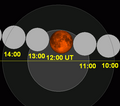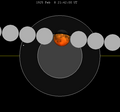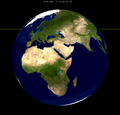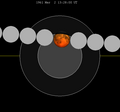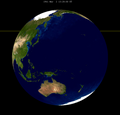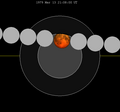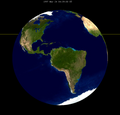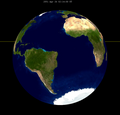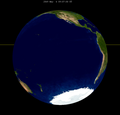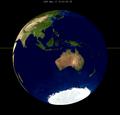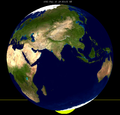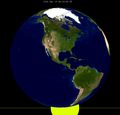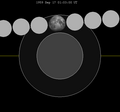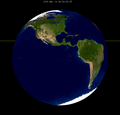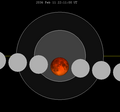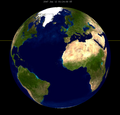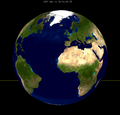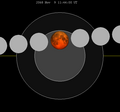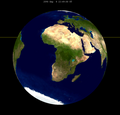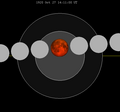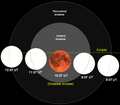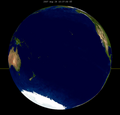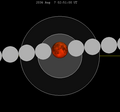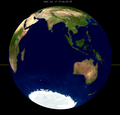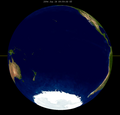Top Qs
Timeline
Chat
Perspective
June 2123 lunar eclipse
Spectacular long central lunar eclipse From Wikipedia, the free encyclopedia
Remove ads
A total lunar eclipse will occur at the Moon’s ascending node of orbit on Wednesday, June 9, 2123,[1] with an umbral magnitude of 1.7488. It will be a central lunar eclipse, in which part of the Moon will pass through the center of the Earth's shadow. A lunar eclipse occurs when the Moon moves into the Earth's shadow, causing the Moon to be darkened. A total lunar eclipse occurs when the Moon's near side entirely passes into the Earth's umbral shadow. Unlike a solar eclipse, which can only be viewed from a relatively small area of the world, a lunar eclipse may be viewed from anywhere on the night side of Earth. A total lunar eclipse can last up to nearly two hours, while a total solar eclipse lasts only a few minutes at any given place, because the Moon's shadow is smaller. Occurring about 1.4 days after apogee (on June 7, 2123, at 19:20 UTC), the Moon's apparent diameter will be smaller.[2]
This dramatic total eclipse, lasting 106 minutes and 6 seconds, will plunge the full Moon into deep darkness as it passes right through the center of the Earth's umbral shadow. While the visual effect of a total eclipse is variable, the Moon may be stained a deep orange or red colour at maximum eclipse. This will be a great spectacle for everyone who sees it. The partial eclipse will last for 3 hours and 56 minutes in total. The penumbral eclipse lasts for 6 hours and 14 minutes. This will be the longest total lunar eclipse since July 16, 2000 (106 minutes, 25 seconds), and the longest one until May 12, 2264 (106 minutes, 13 seconds) and July 27, 3107 (106 minutes, 21 seconds), though the eclipse on June 19, 2141 will be nearly identical in all aspects.[3] This will also be the longest of the 22nd century and the second longest of the 3rd millennium.[4] The eclipse on June 19, 2141 will be the second longest of the 22nd century and the third longest of the third millennium (at 106 minutes 5 seconds).
Remove ads
Visibility
The eclipse will be completely visible over eastern and central North America, South America, and Antarctica, seen rising over western North America, eastern Australia, and the central Pacific Ocean and setting over Europe, Africa, and the Middle East.
Eclipse details
Shown below is a table displaying details about this particular solar eclipse. It describes various parameters pertaining to this eclipse.[5]
Remove ads
Eclipse season
This eclipse is part of an eclipse season, a period, roughly every six months, when eclipses occur. Only two (or occasionally three) eclipse seasons occur each year, and each season lasts about 35 days and repeats just short of six months (173 days) later; thus two full eclipse seasons always occur each year. Either two or three eclipses happen each eclipse season. In the sequence below, each eclipse is separated by a fortnight. The first and last eclipse in this sequence is separated by one synodic month.
Related eclipses
Summarize
Perspective
Eclipses in 2123
- A partial solar eclipse on May 25.
- A total lunar eclipse on June 9.
- A partial solar eclipse on June 23.
- A partial solar eclipse on November 18.
- A total lunar eclipse on December 3.
Metonic
- Preceded by: Lunar eclipse of August 20, 2119
- Followed by: Lunar eclipse of March 28, 2127
Tzolkinex
- Preceded by: Lunar eclipse of April 27, 2116
- Followed by: Lunar eclipse of July 21, 2130
Half-Saros
- Preceded by: Solar eclipse of June 3, 2114
- Followed by: Solar eclipse of June 13, 2132
Tritos
- Preceded by: Lunar eclipse of July 9, 2112
- Followed by: Lunar eclipse of May 8, 2134
Lunar Saros 132
- Preceded by: Lunar eclipse of May 28, 2105
- Followed by: Lunar eclipse of June 19, 2141
Inex
- Preceded by: Lunar eclipse of June 28, 2094
- Followed by: Lunar eclipse of May 18, 2152
Triad
- Preceded by: Lunar eclipse of August 7, 2036
- Followed by: Lunar eclipse of April 10, 2210
Lunar eclipses of 2121–2125
This eclipse is a member of a semester series. An eclipse in a semester series of lunar eclipses repeats approximately every 177 days and 4 hours (a semester) at alternating nodes of the Moon's orbit.[6]
The penumbral lunar eclipses on February 2, 2121 and July 30, 2121 occur in the previous lunar year eclipse set, and the penumbral lunar eclipses on April 18, 2125 and October 12, 2125 occur in the next lunar year eclipse set.
Saros 132
This eclipse is a part of Saros series 132, repeating every 18 years, 11 days, and containing 71 events. The series started with a penumbral lunar eclipse on May 12, 1492. It contains partial eclipses from August 16, 1636 through March 24, 1997; total eclipses from April 4, 2015 through August 2, 2213; and a second set of partial eclipses from August 13, 2231 through November 30, 2411. The series ends at member 71 as a penumbral eclipse on June 26, 2754.
The longest duration of totality will be produced by member 36 at 106 minutes, 6 seconds on June 9, 2123. All eclipses in this series occur at the Moon’s ascending node of orbit.[7]
Eclipses are tabulated in three columns; every third eclipse in the same column is one exeligmos apart, so they all cast shadows over approximately the same parts of the Earth.
Tritos series
This eclipse is a part of a tritos cycle, repeating at alternating nodes every 135 synodic months (≈ 3986.63 days, or 11 years minus 1 month). Their appearance and longitude are irregular due to a lack of synchronization with the anomalistic month (period of perigee), but groupings of 3 tritos cycles (≈ 33 years minus 3 months) come close (≈ 434.044 anomalistic months), so eclipses are similar in these groupings.
Inex series
This eclipse is a part of the long period inex cycle, repeating at alternating nodes, every 358 synodic months (≈ 10,571.95 days, or 29 years minus 20 days). Their appearance and longitude are irregular due to a lack of synchronization with the anomalistic month (period of perigee). However, groupings of 3 inex cycles (≈ 87 years minus 2 months) comes close (≈ 1,151.02 anomalistic months), so eclipses are similar in these groupings.
Half-Saros cycle
A lunar eclipse will be preceded and followed by solar eclipses by 9 years and 5.5 days (a half saros).[9] This lunar eclipse is related to two total solar eclipses of Solar Saros 139.
| June 3, 2114 | June 13, 2132 |
|---|---|
 |
 |
Remove ads
References
Wikiwand - on
Seamless Wikipedia browsing. On steroids.
Remove ads








